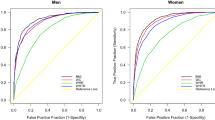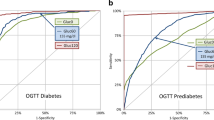Abstract
Background
Obesity represents a global health crisis, yet a dichotomy is emerging with classification according to the metabolic state into metabolically healthy obesity (MHO) and metabolically unhealthy obesity (MUO). This study aimed to identify distinctive systemic clinical/endocrinological parameters between MHO individuals, employing a comprehensive comparative analysis of 50 biomarkers. Our emphasis was on routine analytes, ensuring cost-effectiveness for widespread use in diagnosing metabolic health.
Subjects/methods
The study included 182 women diagnosed with obesity referred for bariatric surgery at the Endocrinology, Diabetes, and Metabolism Service of São João Hospital and University Centre in Portugal. MUO was defined by the presence of at least one of the following metabolic disorders: diabetes, hypertension, or dyslipidemia. Patients were stratified based on the diagnosis of these pathologies.
Results
Significantly divergent health-related parameters were observed between MHO and MUO patients. Notable differences included: albumin (40.1 ± 2.2 vs 40,98 ± 2.6 g/L, p value = 0.017), triglycerides (110.7 ± 51.1 vs 137.57 ± 82.6 mg/dL, p value = 0.008), glucose (99.49 ± 13.0 vs 119.17 ± 38.9 mg/dL, p value < 0.001), glycated hemoglobin (5.58 ± 0.4 vs 6.15 ± 1.0%, p value < 0.001), urea (31.40 ± 10.0 vs 34.61 ± 10.2 mg/dL, p value = 0.014), total calcium (4.64 ± 0.15 vs 4.74 ± 0.17 mEq/L, 1 mEq/L = 1 mg/L, p value < 0.001), ferritin (100.04 ± 129.1 vs 128.55 ± 102.1 ng/mL, p value = 0.005), chloride (104.68 ± 1.5 vs 103.04 ± 2.6 mEq/L, p value < 0.001), prolactin (13.57 ± 6.3 vs 12.47 ± 7.1 ng/mL, p value = 0.041), insulin (20.36 ± 24.4 vs 23.87 ± 19.6 μU/mL, p value = 0.021), c peptide (3.78 ± 1.8 vs 4.28 ± 1.7 ng/mL, p value = 0.003), albumin/creatinine ratio (15.41 ± 31.0 vs 48.12 ± 158.7 mg/g creatinine, p value = 0.015), and whole-body mineral density (1.27 ± 0.1 vs 1.23 ± 0.1 g/cm2, p value = 0.016).
Conclusions
Our findings highlight potential additional parameters that should be taken into consideration alongside the commonly used biomarkers for classifying metabolic health in women. These include albumin, urea, total calcium, ferritin, chloride, prolactin, c-peptide, albumin-creatinine ratio, and whole-body mineral density. Moreover, our results also suggest that MHO may represent a transitional phase preceding the development of the MUO phenotype.
This is a preview of subscription content, access via your institution
Access options
Subscribe to this journal
Receive 12 print issues and online access
$259.00 per year
only $21.58 per issue
Buy this article
- Purchase on Springer Link
- Instant access to full article PDF
Prices may be subject to local taxes which are calculated during checkout


Similar content being viewed by others
Data availability
The datasets generated during and/or analysed during the current study are not publicly available due to privacy or ethical restrictions.
References
Purnell JQ. Definitions, classification, and epidemiology of obesity. Endotext [Internet]. 2023; https://www.ncbi.nlm.nih.gov/books/NBK279167/.
Kinlen D, Cody D, O’Shea D. Complications of obesity. QJM. 2018;111:437–443.
Blüher M. Metabolically healthy obesity. Endocr Rev. 2020;41:bnaa004.
Phillips CM. Metabolically healthy obesity: definitions, determinants and clinical implications. Rev Endocr Metab Disord. 2013;14:219–27.
Stefan N, Häring HU, Hu FB, Schulze MB. Metabolically healthy obesity: epidemiology, mechanisms, and clinical implications. Lancet Diabetes Endocrinol. 2013;1:152–62.
Smith GI, Mittendorfer B, Klein S. Metabolically healthy obesity: facts and fantasies. J Clin Investig. 2019;129:3978–89.
Mayoral LP, Andrade GM, Mayoral EP, Huerta TH, Canseco SP, Rodal Canales FJ, et al. Obesity subtypes, related biomarkers & heterogeneity. Indian J Med Res. 2020;151:11–21.
Rey‐López JP, de Rezende LF, Pastor‐Valero M, Tess BH. The prevalence of metabolically healthy obesity: a systematic review and critical evaluation of the definitions used. Obes Rev. 2014;15:781–90.
Stefan N. Causes, consequences, and treatment of metabolically unhealthy fat distribution. Lancet Diabetes Endocrinol. 2020;8:616–27.
Stefan N, Schulze MB. Metabolic health and cardiometabolic risk clusters: implications for prediction, prevention, and treatment. Lancet Diabetes Endocrinol. 2023;11:426–40.
Jelliffe D, Jelliffe E. Underappreciated pioneers. Quetelet: man and index. Am J Clin Nutr. 1979;32:2519–21.
Lavie CJ, Laddu D, Arena R, Ortega FB, Alpert MA, Kushner RF. Healthy weight and obesity prevention: JACC health promotion series. J Am Coll Cardiol. 2018;72:1506–31.
van Vliet-Ostaptchouk JV, Nuotio ML, Slagter SN, Doiron D, Fischer K, Foco L, et al. The prevalence of metabolic syndrome and metabolically healthy obesity in Europe: a collaborative analysis of ten large cohort studies. BMC Endocr Disord. 2014;14:9.
Liu C, Wang C, Guan S, Liu H, Wu X, Zhang Z, et al. The prevalence of metabolically healthy and unhealthy obesity according to different criteria. Obes Facts. 2019;12:78–90.
Hamer M, Bell JA, Sabia S, Batty GD, Kivimäki M. Stability of metabolically healthy obesity over 8 years: the English longitudinal study of ageing. Eur J Endocrinol. 2015;173:703–08.
Fanali G, Di Masi A, Trezza V, Marino M, Fasano M, Ascenzi P. Human serum albumin: from bench to bedside. Mol Asp Med. 2012;33:209–90.
Luís C, Baylina P, Soares R, Fernandes R. Metabolic dysfunction biomarkers as predictors of early diabetes. Biomolecules. 2021;11:1589.
Kunutsor SK, Apekey TA, Walley J, Kain K. Ferritin levels and risk of type 2 diabetes mellitus: an updated systematic review and meta-analysis of prospective evidence. Diabetes Metab Res Rev. 2013;29:308–18.
Zhang W, Zheng J, Zhang J, Li N, Yang X, Fang ZZ, et al. Associations of serum amino acids related to urea cycle with risk of chronic kidney disease in Chinese with type 2 diabetes. Front Endocrinol (Lausanne). 2023;14:1117308.
Kopelman P. Physiopathology of prolactin secretion in obesity. Int J Obes. 2000;24:S104–S108.
Tanner MJ, Hadlow NC, Wardrop R. Variation of female prolactin levels with menopausal status and phase of menstrual cycle. Aust N Z J Obstet Gynaecol. 2011;51:321–4.
Turcotte AF, O’Connor S, Morin SN, Gibbs JC, Willie BM, Jean S, et al. Association between obesity and risk of fracture, bone mineral density and bone quality in adults: a systematic review and meta-analysis. PLoS One. 2021;16:e0252487.
Lonardo A, Mantovani A, Lugari S, Targher G. Epidemiology and pathophysiology of the association between NAFLD and metabolically healthy or metabolically unhealthy obesity. Ann Hepatol. 2020;19:359–66.
Pfortmueller CA, Uehlinger D, von Haehling S, Schefold JC. Serum chloride levels in critical illness—the hidden story. Intensive Care Med Exp. 2018;6:10.
Wahren J, Ekberg K, Johansson J, Henriksson M, Pramanik A, Johansson BL, et al. Role of C-peptide in human physiology. Am J Physiol Endocrinol Metab. 2000;278:E759–E768.
Hills CE, Brunskill NJ. Cellular and physiological effects of C-peptide. Clin Sci. 2009;116:565–74.
Rossi MCE, Nicolucci A, Pellegrini F, Comaschi M, Ceriello A, Cucinotta D, et al. Obesity and changes in urine albumin/creatinine ratio in patients with type 2 diabetes: the DEMAND Study. Nutr Metab Cardiovasc Dis. 2010;20:110–16.
Du N, Peng H, Chao X, Zhang Q, Tian H, Li H. Interaction of obesity and central obesity on elevated urinary albumin-to-creatinine ratio. PLoS One. 2014;9:98926.
Acknowledgements
The authors would like to acknowledge the patients enrolled in this study. Carla Luís acknowledges FCT—Fundação para a Ciência e Tecnologia by a doctoral scholarship (SFRH/BD/146489/2019).
Author information
Authors and Affiliations
Consortia
Contributions
Conceptualization: FM, CL; methodology: FM, CL; validation: RF, RS, ELC; formal analysis: FM, CL; resources and methodology: PS, TM, PF, IR, DF, JP, AV, AR; supervision: PF, RF, RS, ELC; Writing—original draft preparation: CL; writing—review, editing, and validation: FM; PS, TM, PF, IR, DF, JP, AV, AR, RF, RS, ELC, CL. All authors have read and agreed to the published version of the manuscript.
Corresponding author
Ethics declarations
Competing interests
There is no competing interest associated with this publication, and there was no significant financial support for this work that could have influenced its outcome.
Informed consent
Informed consent was obtained from all subjects involved in the study.
Additional information
Publisher’s note Springer Nature remains neutral with regard to jurisdictional claims in published maps and institutional affiliations.
Supplementary information
Rights and permissions
Springer Nature or its licensor (e.g. a society or other partner) holds exclusive rights to this article under a publishing agreement with the author(s) or other rightsholder(s); author self-archiving of the accepted manuscript version of this article is solely governed by the terms of such publishing agreement and applicable law.
About this article
Cite this article
Mendonça, F., Soares, P., Moreno, T. et al. Distinguishing health-related parameters between metabolically healthy and metabolically unhealthy obesity in women. Int J Obes (2024). https://doi.org/10.1038/s41366-024-01519-1
Received:
Revised:
Accepted:
Published:
DOI: https://doi.org/10.1038/s41366-024-01519-1



